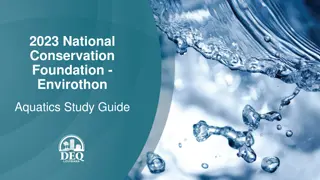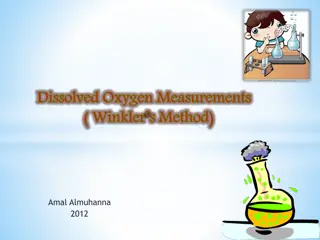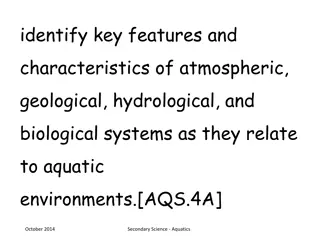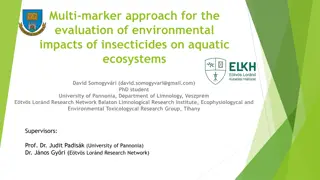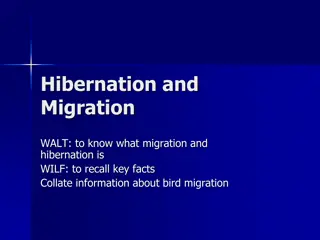Exploring The Best Swim School To Start Your Aquatic Journey
Are you trying to find the Best Swim School to start your aquatic career? Ace Dolphin is the only place to look. Ace Dolphin, which is well-known for its dedication to quality, provides amazing swimming programs for people of all ages and skill levels. Let\u2019s explore why Ace Dolphin is an ideal
1 views • 3 slides
Dissolved Oxygen Measurements and Factors Affecting Oxygen Levels
Understanding the importance of dissolved oxygen in water is crucial for the survival of aquatic plants and animals. Factors such as chemical reactions, temperature, pressure, and light penetration influence oxygen levels. The Winkler method is commonly used for dissolved oxygen measurements. This m
6 views • 11 slides
2023 National Conservation Foundation - Envirothon
Explore the intricate dynamics of aquatic ecosystems and wetlands conservation through this comprehensive study guide. Discover the importance of watersheds, the hydrologic cycle, aquatic food webs, energy flow at trophic levels, and common macroinvertebrates in Louisiana. Learn about different wetl
3 views • 27 slides
Adaptations of Aquatic Specimens, with a Focus on Sea Snakes
Aquatic specimens, particularly sea snakes of the subfamily Hydrophiinae, exhibit fascinating adaptations for their fully aquatic lifestyle. These marine snakes are uniquely adapted for life in the sea, with specialized features such as paddle-like tails, compressed bodies, and the ability to respir
0 views • 16 slides
The Prevention of Cruelty to Animals Act, 1960 Overview
The Prevention of Cruelty to Animals Act, 1960, is a legislation in India aimed at safeguarding the well-being of animals and preventing unnecessary pain or suffering. It defines important terms like animals, domestic animals, local authority, owner, and outlines the responsibilities of individuals
0 views • 16 slides
Common Offences Against Animals in India: Overview and Consequences
There are three common offences against animals in India: mischief, cruelty, and bestiality. Mischief involves killing, poisoning, or harming animals, punishable under IPC Sections 428 and 429. Cruelty includes acts like beating, overloading, and starvation, regulated by the Prevention of Cruelty to
1 views • 21 slides
Sustainable Aquaculture Products Attract Environmentally Conscious Consumers
Aquaculture Market By Product Types(Equipment, Chemicals, Pharmaceuticals, Fertilizers), By Culture(Fresh Water, Brackish Water, Marine Water), By Species( Aquatic Plants, Aquatic Animals), By End-User(Seafood Industry, Pharmaceuticals, Others), By R
0 views • 4 slides
The Evolution of Aquarium Societies in Texas: A Historical Journey from 1932 to 2019
Explore the history of FOTAS - the Federation of Texas Aquarium Societies, from its inception in 1952 to its evolution into a yearly convention. Discover the chronology of aquatic organizations in Texas from the 1930s, including the formation of various aquarium clubs and their contributions to the
0 views • 33 slides
Respiration in Mollusca: Adaptations to Different Habitats
Mollusca exhibit various modes of respiration depending on their habitat - aquatic, terrestrial, or amphibious. Different respiratory organs are modified accordingly, such as ctenidia or gills for aquatic species, pulmonary sac for aerial species, and mantle or integument for those lacking specific
0 views • 17 slides
Animals by Walt Whitman: Embracing the Virtues of Animals Over Humans
Walt Whitman's poem "Animals" expresses a longing to live among animals due to their peaceful and self-controlled nature, contrasting them with the perceived greed and jealousy of humans. The poet finds solace in the virtues displayed by animals and reflects on their simplicity and contentment, high
0 views • 16 slides
Discover the Benefits of Joining NISCA - Your Professional Organization for High School Aquatic Sports Coaches
Unlock a world of opportunities with NISCA, the leading professional organization for high school swimming, diving, and water polo coaches. Representing a vast community of swimmers, divers, and water polo players, NISCA offers avenues for leadership involvement through state directors, zone directo
1 views • 8 slides
Overview of Laboratory Animals and Their Uses in Biomedical Research
Laboratory animals play a crucial role in biomedical research, serving as models for studying various conditions affecting humans and animals. They must thrive in controlled conditions and are used to test hypotheses and drugs. Commonly used lab animals include rodents, lagomorphs, canines, felines,
0 views • 9 slides
Aquatic Adaptation in Animals
Aquatic adaptation refers to the changes in an animal's body organization to thrive in a water habitat. Vertebrates have evolved to lead partial or total aquatic lives, showcasing various adaptations. Water as a habitat offers a homogenous medium, stable conditions, and rich food resources. Aquatic
1 views • 9 slides
Aquatic Pollution and Its Impact on Water Quality
Aquatic pollution is a significant concern affecting the environment and human health. It includes various pollutants entering water bodies from land-based activities, causing harm to aquatic life and humans. Pollution sources can be classified into point source and non-point source. Monitoring wate
2 views • 13 slides
Dissolved Oxygen Measurement and Factors Affecting Oxygen Levels
The content highlights the importance of measuring dissolved oxygen levels in water bodies for aquatic life survival. It explains the factors influencing oxygen concentrations, the principles of Winkler's method for measurement, required materials, and the testing procedure involved. The significanc
2 views • 11 slides
Service and Assistance Animals Guidelines at RIT
Service and Assistance Animals Guidelines at RIT provide information on the definition of service and assistance animals, request procedures, expectations of animal and owner, and how to address concerns. The policy distinguishes between service animals trained to perform tasks for individuals with
1 views • 15 slides
West Union Aquatic Center Cardboard Regatta Event Details
This event is all about constructing cardboard boats and competing in a fun-filled race at the West Union Aquatic Center. Participants must build their boats with cardboard and duct tape and adhere to specific race rules. The event promotes teamwork, creativity, and problem-solving skills while offe
0 views • 14 slides
Efficient Roster Model for Aquatic Facilities in Greater Geelong
The Roster Model developed by the City of Greater Geelong aims to improve efficiencies, quality assurance, reporting, and data analysis in aquatic facilities. By introducing a point score system for group exercise and transitioning to an online system, the model ensures accurate rostering, staff ava
0 views • 18 slides
Aquatic Treatment Systems for Wastewater Reclamation and Reuse
In aquatic systems, wastewater treatment involves bacterial metabolism and sedimentation, with aquatic plants playing a role in improving treatment capabilities. This article discusses the functions of aquatic plants in treatment systems and the categories of wetlands used for wastewater treatment,
1 views • 15 slides
Service Animals for Veterans in Georgia: A Guide to VA Guidance
Veterans in Georgia can benefit from service animals, including guide dogs and trained service animals, to assist with physical or mental impairments. The VA provides guidelines for evaluating, approving, and supporting veterans in receiving and caring for service animals. This includes information
0 views • 8 slides
The Iron Cycle and Aquatic Microbiology
Iron plays a crucial role in terrestrial and marine ecosystems, cycling between living organisms and the geosphere. It is a vital nutrient for plants, essential for chlorophyll production, and for animals, needed to create hemoglobin. The marine iron cycle involves phytoplankton and cyanobacteria as
0 views • 19 slides
Animal Welfare and Five Freedoms in Farming
Animal welfare encompasses physical and mental wellbeing, allowing animals to express natural behaviors. The Five Freedoms outline essential welfare needs, making sure animals are free from hunger, discomfort, pain, fear, and distress. The Farm Animal Welfare Council ensures these needs are met for
2 views • 16 slides
Thermal Pollution and Its Sources
Thermal pollution is the detrimental effect of heated effluents discharged by power plants on aquatic and terrestrial ecosystems. This pollution occurs when the temperature of water bodies rises significantly due to human activities, leading to a reduction in dissolved oxygen and impacting aquatic l
0 views • 19 slides
Identification of Aquatic Plants in Freshwater Bodies Based on Habitat Classification
Before identifying aquatic plants in freshwater bodies, it's vital to classify them into floating macrophytes, marginal macrophytes, submerged macrophytes, and emergent macrophytes. This classification aids in distinguishing various plant species such as Eichhornia, Salvinia, Pistia, Lemna, and Azol
0 views • 9 slides
Insight Into the Adaptations and Habits of Aquatic Freshwater Eels
The Anguillidae family includes freshwater eels with snake-like bodies, dwelling in diverse habitats. Their catadromous nature involves migrating to the ocean to breed. Freshwater eels serve dual roles as predator and prey, displaying unique feeding behaviors. Their body structures feature elongated
0 views • 15 slides
Conservation Plan for Aquatic Habitat Restoration in New Braunfels
This plan outlines various projects aimed at managing aquatic habitats in New Braunfels for the restoration and preservation of native species such as the fountain darter. It includes objectives like flow manipulation, non-native vegetation control, and restoration of aquatic vegetation in the Comal
0 views • 17 slides
Fertilisation and Embryo Development in Animals
The process of reproduction in animals involves the crucial step of fertilisation, where a sperm fuses with an egg to form a zygote. There are two main types of fertilisation - internal and external. Internal fertilisation occurs within the female body, as seen in humans, cows, and other animals. On
0 views • 16 slides
Proposal to Update New Mexico Water Quality Standards: Copper Site-Specific Water Quality Criteria for the Pajarito Plateau
Develop a proposal for the New Mexico Water Quality Control Commission to adopt EPA's 2007 recommended copper ambient water quality criteria, focusing on the history of U.S. EPA aquatic life criteria for copper, the use of the BLM tool in aquatic toxicology, and the overview of proposed site-specifi
1 views • 10 slides
Aquatic Therapy: Benefits, Techniques, and Research Findings
Aquatic therapy, presented by Beverly Knight, SPT, offers a unique approach to rehabilitation with properties of water like buoyancy and resistance. This therapy can benefit patients with various conditions such as chronic pain, arthritis, and neurological impairments. The content covers indications
0 views • 22 slides
Environmental Review and Conservation Efforts for Aquatic Weed Control at Tahoe Keys Lagoons
In an effort to address the aquatic weed issue at Tahoe Keys Lagoons, a full environmental review is underway with proposed herbicide discharge into the waters. The project aims to find an environmentally superior alternative for controlling weeds while ensuring minimal impact on the environment and
0 views • 8 slides
Marine Aquaculture Impacts on Submersed Aquatic Vegetation
The document explores the impacts of structures and shading used in commercial shellfish mariculture activities on submersed aquatic vegetation, particularly seagrasses. It discusses the varying effects of mariculture structures on eelgrass density, productivity, and the potential habitat they provi
0 views • 11 slides
Food Webs in Aquatic Habitats
Exploring the intricate relationships within aquatic food webs, this content delves into the control of beneficial and pest species, highlighting the importance of biodiversity and the factors that influence species presence and success. From the role of frogs in the ecosystem to the impact on tadpo
1 views • 6 slides
Learn Where Different Animals Live - Educational English Lesson for Class Two Students
In this engaging English lesson designed for Class Two students, they will explore where animals live through visual aids and interactive learning activities. The lesson covers various animals like birds, snakes, cows, tigers, and more, teaching students about their habitats in a fun and educational
0 views • 22 slides
Managing Service Animals and Emotional Support Animals in Compliance with ADA and HUD Guidelines
This presentation by James Whitfield explores the management of service animals and emotional support animals on campus under OCR and HUD guidelines. The session covers defining service animals, identifying them in training, recognizing emotional support animals, and understanding the distinctions b
1 views • 52 slides
Wildlife Warden Duties and Performing Animals Welfare Guidelines
Every state and union territory in India has a Wildlife Advisory Board to aid in wildlife protection, with Wildlife Wardens playing a key role in conservation efforts. They focus on preventing poaching, protecting wildlife habitats, and engaging with local communities. Additionally, guidelines are s
0 views • 8 slides
Aquatic Environments: Systems and Interactions
Explore the key features and characteristics of atmospheric, geological, hydrological, and biological systems in relation to aquatic environments. Apply systems thinking to analyze positive and negative feedback cycles. Utilize technology to collect and evaluate global environmental data. Evaluate d
0 views • 28 slides
Multi-Marker Approach for Evaluating Environmental Impacts of Neonicotinoids on Aquatic Ecosystems
Neonicotinoids, a class of insecticides, are widely used in agriculture but pose environmental risks to aquatic organisms. This study by David Somogyvári explores the effects of neonicotinoids on aquatic ecosystems using a multi-marker approach, focusing on the toxicity levels and potential impacts
0 views • 18 slides
Aquatic Adaptations in Marine Life
This informative content discusses the primary and secondary aquatic adaptations in marine animals such as fish, whales, turtles, and ducks. It covers various adaptations like streamlined bodies, presence of swim bladders, flippers for navigation, and webbed feet for swimming. Each adaptation is vit
1 views • 14 slides
Migration and Hibernation in Animals
Explore the fascinating behaviors of birds during migration and animals during hibernation. Discover how animals adapt to survive in changing environments, the reasons behind hibernation, dangers involved, and how different animals prepare for winter. Learn about light sleepers that are not true hib
0 views • 17 slides
Aquatic Facility Regulation and Guidance Reviews
This content covers regulations, reviews, and consultations related to aquatic facilities in Victoria, focusing on public health and wellbeing legislation. It includes information on maintaining aquatic facilities, water quality requirements, policy analysis, and consultation feedback to address pat
0 views • 11 slides


